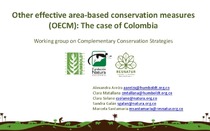| dc.creator | Arenas-Castro, Alexandra | |
| dc.creator | Matallana-Tobón, Clara L. | |
| dc.creator | Solano, Clara | |
| dc.creator | Galán, Sandra | |
| dc.creator | Santamaría, Marcela | |
| dc.date.accessioned | 2018-01-23T17:16:03Z | |
| dc.date.available | 2018-01-23T17:16:03Z | |
| dc.date.issued | 2017-07-23 | |
| dc.identifier.uri | http://hdl.handle.net/20.500.11761/34205 | |
| dc.description.abstract | Colombia has made considerable efforts to accomplish the Aichi target 11, by strengthening current protected ICCB2017 Book of Abstracts • Page 155 Cartagena, Colombia • 23-27 July 2017 SYMPOSIUM PRESENTATIONS areas and establishing new ones in ecosystems poorly represented on the national protected area system. Nevertheless, it is well known that countries will hardly achieved the Aichi target 11 by 2020 if they do not take into account Other Effective Area-based Conservation Measures - OECM. The IUCN´s World Commission on Protected Areas, specifically the Task Force on OECM, is working to establish criteria to recognize those measures and avoid misunderstandings on the issue. In those areas, conservation should be de facto, and could include areas where conservation is partial, voluntary or even ancillary. In Colombia, several efforts have been made to increase visibility and recognize different conservation strategies, some of them known as Complementary Conservation Strategies. These measures include different governance arrangements and can range from private lands to community-managed territories. The aim of this work is to presents a collection of representative cases, as well as an analysis of the criteria and the screening tool that was proposed by the IUCN, in order to identify the areas that could be consider as an OECM. We present a compilation of 45 different, with different types of governance and located in different ecosystems of the country. The analysis provides a feedback the UICN proposal and to give advice to other countries about the threshold on identifying and recognizing different measures. Some considerations in issues such as reporting, monitoring, reporting and management of this areas are made. We propose some steps to continue the process: Compilation of information on OECM from community, institutions, private sector, etc.; Promote Recognition of different forms and levels of governance; include all the stakeholders in the discussion; creating awareness on the role and importance of OECM on biodiversity conservation | eng |
| dc.format.extent | 14 p. | spa |
| dc.language.iso | en | spa |
| dc.publisher | Society for Conservation Biology | spa |
| dc.relation.uri | http://conbio.org/mini-sites/iccb-2017 | spa |
| dc.rights | Atribución-NoComercial 2.5 Colombia | * |
| dc.rights.uri | http://creativecommons.org/licenses/by-nc/2.5/co/ | * |
| dc.source | reponame: Repositorio Institucional de Documentación Científica Humboldt | spa |
| dc.source | instname: Instituto de Investigación de Recursos Biológicos Alexander von Humboldt | spa |
| dc.subject | Áreas protegidas | spa |
| dc.subject | Gobernanza | spa |
| dc.subject | Conservación | spa |
| dc.title | Other effective area-based conservation measures (OECM): The case of Colombia | spa |
| dc.type | info:eu-repo/semantics/conferenceObject | spa |
| dc.description.ciudad | Cartagena, Colombia | spa |
| dc.description.programa | Gestión Territorial de la Biodiversidad | spa |
| dc.description.event | 28th ICCB 2017 - Congreso Internacional de Biología de la Conservación | spa |




